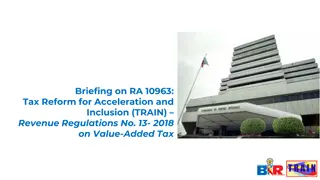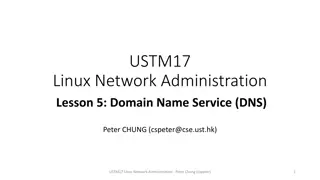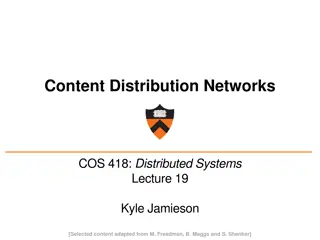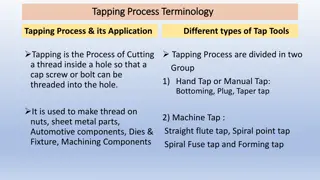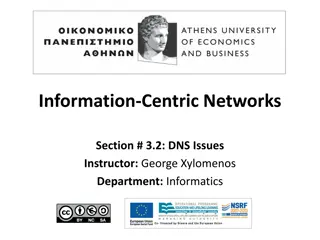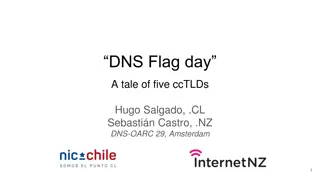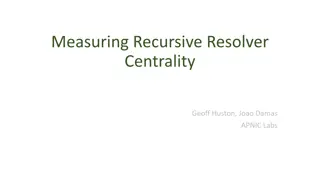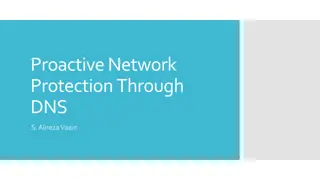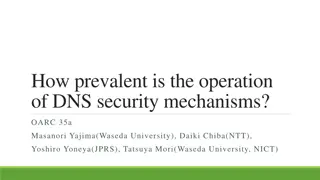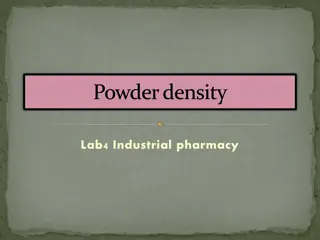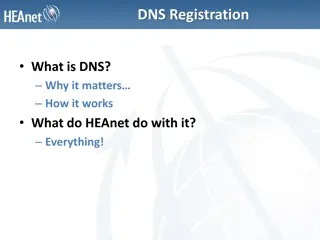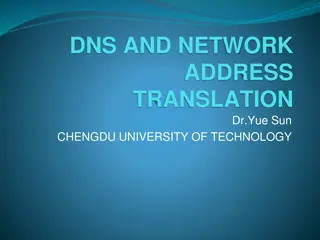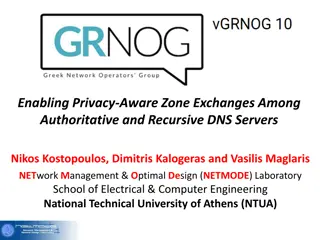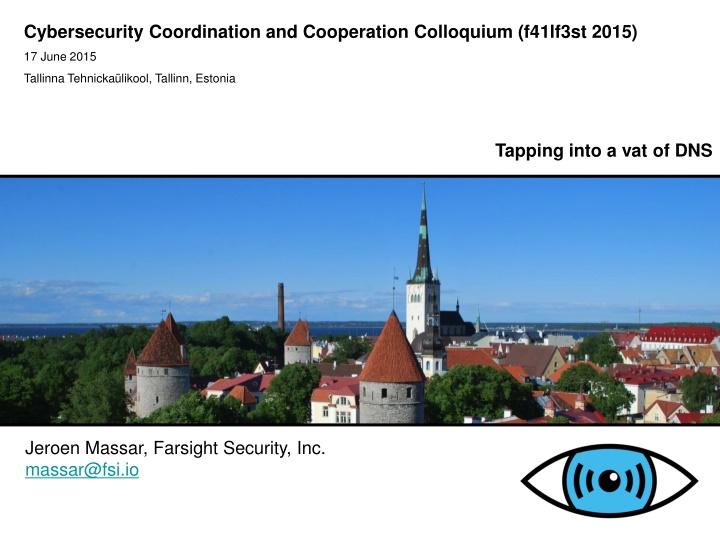
Enhancing Cybersecurity Through DNS Management Techniques
Explore the innovative DNS management strategies discussed at the Cybersecurity Coordination and Cooperation Colloquium 2015. Learn about Response Rate Limiting, BCP38, DNS query collection, and more for bolstering network security against DDoS attacks and botnet connections via DNS queries.
Download Presentation

Please find below an Image/Link to download the presentation.
The content on the website is provided AS IS for your information and personal use only. It may not be sold, licensed, or shared on other websites without obtaining consent from the author. If you encounter any issues during the download, it is possible that the publisher has removed the file from their server.
You are allowed to download the files provided on this website for personal or commercial use, subject to the condition that they are used lawfully. All files are the property of their respective owners.
The content on the website is provided AS IS for your information and personal use only. It may not be sold, licensed, or shared on other websites without obtaining consent from the author.
E N D
Presentation Transcript
Cybersecurity Coordination and Cooperation Colloquium (f41lf3st 2015) 17 June 2015 Tallinna Tehnicka likool, Tallinn, Estonia Tapping into a vat of DNS Jeroen Massar, Farsight Security, Inc. massar@fsi.io IPv6 Golden Networks
Farsight Security, Inc. http://www.farsightsecurity.com CEO: Dr. Paul Vixie Team based in US, Canada and Switzerland Security defense and insight based on DNS Major projects: SIE (Security Information Exchange) DNSDB (DNS Database) NOD (Newly Observed Domains) ::2 Jeroen Massar f41lf3st
Simplified DNS Overview ::3 Jeroen Massar f41lf3st
Response Rate Limiting (RRL) NTP DDoS attacks are common and big as amplification factor is large, large number of open recursors, large number of networks that allow spoofing RRL Limits the number of unique responses returned by a DNS server per eg IPv4 /24, or IPv6 /48 RRL makes informed decision, simple IP-based rate limiting would just randomly drop queries Implemented in: NSD, BIND, Knot, more coming Credits: Paul Vixie & Vernon Schryver More details: http://www.redbarn.org/dns/ratelimits ::4 Jeroen Massar f41lf3st
RRL Example BIND Configuration in options section of configuration: rate-limit { responses-per-second 15; window 5; }; Graph courtesy of Peter Losher / ISC F-Root, when they enabled RRL on their Amsterdam node ::5 Jeroen Massar f41lf3st
BCP38 http://tools.ietf.org/html/bcp38 http://www.bcp38.info ::6 Jeroen Massar f41lf3st
DNS Query collection Useful for determining what sites are visited/looked-up Can indicate that a client in the network is connecting to a known C&C Botnet when using DNS ::7 Jeroen Massar f41lf3st
Query Logging DNS Server logs queries to disk (file or syslog) Slows DNS server itself down as syslog/file-writing is typically a blocking operation Text-based, thus requires formatting/parsing and the overhead of ASCII Lose all details not logged ::8 Jeroen Massar f41lf3st
Passive DNS Use a hub/mirror-port etc to sniff the interface of the DNS server collection DNS responses Full packet details, which need to be parsed Requires TCP reassembly and UDP fragment reassembly No performance impact on the actual DNS server Can be done below and above the recursive ::9 Jeroen Massar f41lf3st
dnstap The best of Query Logging + Passive DNS: dnstap Patch the DNS server to support logging using dnstap Duplicates the internal parsed DNS format message Uses circular queues & non-blocking logging techniques: minimal performance hit on DNS server Implemented in Bind, Unbound, Knot DNS and more Documentation / Tutorials / Mailinglist / Code:http://www.dnstap.info Design & Implementation: Robert Edmonds ::10 Jeroen Massar f41lf3st
DNSTap Big Overview ::11 Jeroen Massar f41lf3st
Response Policy Zone (RPZ) Website with more details: http://www.dnsrpz.info Also dubbed DNS Firewalls Rules are carried in standard DNS zones Using IXFR, NOTIFY, TSIG zone updates are distributed automatically and efficiently to stealth secondaries Depending on rule, a different response might be returned than the real one ::12 Jeroen Massar f41lf3st
RPZ: Rule Types Rules: If the name being looked up is W. If the response contains any IP address in range X. If a listed name server name is Y. If any returned name server IP address is in range Z. ::13 Jeroen Massar f41lf3st
RPZ Actions Synthesize NXDOMAIN. www.infected.example.@ CNAME . Synthesize NODATA: www.infected.example.@ CNAME *. Synthesize an answer. www.infected.example.@ CNAME www.antivirus.example. www.malificent.example.@ AAAA 2001:db8::42 Answer with the truth by not having an entry. ::14 Jeroen Massar f41lf3st
RPZ Examples BIND configuration options to enable 4 RPZ feeds: response-policy { zone "rpz.deteque.com ; zone rpz.surbl.org ; zone rpz.spamhaus.org ; zone rpz.iidrpz.net ; }; Note that RPZ servers are ACLd, hence need permission of operator to get access to the data ::15 Jeroen Massar f41lf3st
DNS Database (DNSDB) Central repository from Passive DNS collectors data Web-based query interface API access for integration in various investigative tools http://www.dnsdb.info / http://api.dnsdb.info ::16 Jeroen Massar f41lf3st
::17 Jeroen Massar f41lf3st
::18 Jeroen Massar f41lf3st
Newly Observed Domains Zone File Access (ZFA) as provided by TLD operator (ICANN Base Registry Agreement) ZFA is not available for eg ccTLDs, .mil etc ZFA is only published every 24 hours Might miss domains that are registered and removed inside that period again (eg domain tasting) Hence: look at DNSDB, as it knows what is being queried. If domain not seen for last 10 days: Newly Observed Domain! Newly Observed Domains (NOD) are published as RPZ zone ::19 Jeroen Massar f41lf3st
Malicious Domains Lifecycle Registration Blocking Hosting Payload Delivery Propagation ::20 Jeroen Massar f41lf3st
Questions? Jeroen Massar massar@fsi.io https://www.farsightsecurity.com ::21 Jeroen Massar f41lf3st


